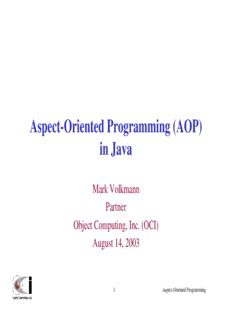Table Of ContentAspect-Oriented Programming (AOP)
in Java
Mark Volkmann
Partner
Object Computing, Inc. (OCI)
August 14, 2003
1 Aspect-Oriented Programming
AOP Overview
• Provides “separation of concerns”
– separating common needs of possibly unrelated classes from those classes
– can share a single implementation across many classes
• much better than modifying many existing classes to address a concern
– changes can be made in one place instead of in multiple classes
• Provides a way to describe concerns
– concerns are encapsulated into “aspects” (more on this later)
• Removes “code tangling”
– implementing more than one concern in one class
both of these reduce
potential for reuse
• Removes “code scattering”
– implementing the same concern in multiple classes
• Not a replacement for object-oriented programming (OOP)
– used in conjunction with it
2 Aspect-Oriented Programming
Common Uses For AOP
(called “concerns” in AOP lingo)
• Authentication
• Caching
• Context passing
• Error handling
• Lazy loading
• Debugging
– logging, tracing, profiling and monitoring
• Performance optimization
• Persistence
• Resource pooling
• Synchronization
• Transactions
3 Aspect-Oriented Programming
AOP Terminology
• concern
- functionality to be consolidated (see common uses on previous page)
• advice
- code that implements a concern
• join point
- a location in code where advice can be executed
• pointcut pointcuts can also identify
- identifies sets of join points
context information to be
• introduction made available to advice
– modify a class to add fields, methods or constructors
– modify a class to extend another class or implement a new interface
• aspect
- associates join points/pointcuts/advice and applies introductions
• crosscutting
- what aspects do to application classes (see next page)
• weaving
- the process of inserting aspect code into other code
• instrumentor
- tool that performs weaving can be done at build-time,
load-time and run-time
4 Aspect-Oriented Programming
Concerns: Crosscutting or Integral?
• Before AOP
– implementations of common concerns were typically shared
between multiple classes by inheriting from a common base class
• All want same?
– when all potential users of the classes would want
the same implementation, the concern is “integral”
– in this situation, inheriting from a common base class is fine
• Some want different?
– when some potential users of the classes may want
a different implementation, the concern is “crosscutting”
• all the typical uses of AOP listed on page are potentially crosscutting
– it’s best to separate these from the classes
in order to maximize their reusability
– AOP gives us this capability!
5 Aspect-Oriented Programming
This is a list of join points
supported by AspectJ.
Join Points
Other implementations tend
to support a subset of these.
For example, Nanning only
supports “method call”.
• Support for specific kinds of join points varies
• Some to look for include
– method call -
in calling code where call is made
– method execution -
in called method before code is executed
– constructor call -
in calling code where call is made
– constructor execution -
in called constructor after super or this calls, but before other code is executed
– field get -
when the value of a field is accessed
– field set -
when the value of a field is modified
– exception handler execution -
before a catch block for an exception executes
– class initialization -
before execution of “static { code }” blocks
– object initialization -
before execution of “{ code }” blocks
6 Aspect-Oriented Programming
Development vs. Production Aspects
• Development aspects
– may want to insert them after code is placed in production
and remove them when finished using
– used for debugging concerns
• Production aspects
– intended to be used in production code
– used for all other concerns listed on page 3
• Some AOP frameworks don’t support
insertion of aspects into production code at run-time
and later removal
7 Aspect-Oriented Programming
Java Weaving Approaches
• Source Generation
Any form of source generation is
an alternative to build-time AOP.
– parse Java source and generate new Java source
For example, XSLT can be used
• Bytecode Modification to generate source code from an
XML document that describes a
– three varieties database schema.
• modify .class files at build-time
• modify bytecode at run-time as it is loaded into the JVM
• modify bytecode at run-time after it has been loaded into the JVM
– great for debugging concerns
• Dynamic Proxies
– create proxy objects at run-time that can delegate to the target object
– can only be used with classes that implement some interface
– code must explicitly create proxy objects
• typically done in a factory method
• if target objects are created using their constructors
then aspects won’t be utilized
8 Aspect-Oriented Programming
Java-based AOP Frameworks
• The following AOP frameworks are discussed later
– AspectJ
– AspectWerkz
– Nanning
– Prose (PROgrammable Service Extensions)
There is debate over whether frameworks that only provide
method interception such as Nanning represent real AOP.
Some refer to them as Aspect-like rather than Aspect-Oriented.
9 Aspect-Oriented Programming
Dynamic Proxies
• Overview
– dynamically generates classes at run-time
that implement given interfaces
– instances of those classes are called “dynamic proxies”
– used as the basis of some AOP frameworks such as Nanning
• Limitations
– can only act as a proxy for classes that implement some interface
– when overriding methods of existing classes, callers must typically
obtain an object from a factory method instead of using a constructor
• existing code that uses constructors must be modified
• Simple to use!
– see example on next page
10 Aspect-Oriented Programming
Description:Aug 14, 2003 Aspect-Oriented Programming. 1. Aspect-Oriented Programming (AOP) in Java.
Mark Volkmann. Partner. Object Computing, Inc. (OCI).

